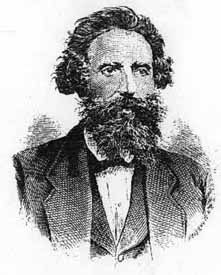
Colonel James Montgomery
Colonel James Montgomery was an abolitionist and Jayhawker during the days of Bleeding Kansas and a Union colonel during the Civil War.
Born to James and Mary Baldwin Montgomery in Austinburg, Ohio, on December 22, 1814, Montgomery later moved with his family to Kentucky in 1837, where he taught school when he grew up. Briefly, he was married in Kentucky, but his wife died just a short time later. He soon remarried, and the couple moved to Missouri in 1852, where they lived in several places awaiting the opening of the Kansas Territory. In 1854, he and his wife settled about five miles west of present-day Mound City, Kansas.
At this time, the area was plunged into the midst of the Kansas-Missouri Border War, and Montgomery soon became a leader of local Free-State men. Just a year after he had moved to Linn County, his cabin was burned down by Missouri guerillas, and he soon built a new home that was more of a fortress and was referred to as Fort Montgomery.
In 1857, he organized and commanded a group called the “Self-Protective Company,” which began to order pro-slavery settlers to leave the area. As the conflicts in the area continued, the current pro-slavery governor sent troops into Southeastern Kansas to quell the disturbances, encouraging the pro-slavery advocates to harass the Free-Staters even more. He often worked with John Brown to make Kansas a free state.
In 1859, he was a candidate for representative in the Kansas Territorial Legislature but was defeated by W. R. Wagstaff. When the Civil War began, he was mustered into the Union Army as a colonel of the Third Kansas Infantry on July 24, 1861. By June 1863, Montgomery commanded his brigade in operations along the east coast that resembled his earlier “Jayhawking” raids. This regiment distinguished itself at the Battle of Olustee, Florida, on February 20, 1864.
In 1864, he resigned from his commission and returned to Linn County, Kansas. He lived peacefully with his wife and seven children and worked as a farmer until December 6, 1871, when he died. He is buried in the National Cemetery in Mound City, Kansas – grave #76.
“He died poor, although he had abundant opportunity to steal himself rich in the name of liberty.”
— Unknown
© Kathy Alexander/Legends of America, updated October 2023.
Also See:
